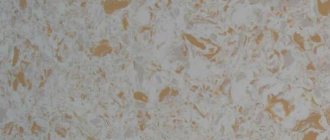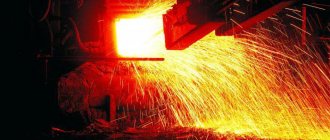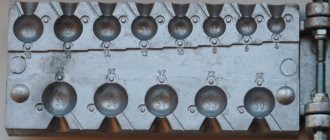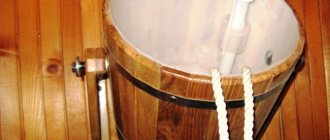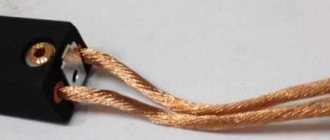This is my first, one might even say, the first attempt in my life to make a copy of a part for a construction set using epoxy resin. And since I have never made split molds before, the topic is more for familiarization than instructions for use. In general, we have such a radiator from the Ashetov model of the Tank and the desire to make the same copy of it, or approximately the same radiator.
I almost forgot, the easiest way is probably to make a mold from silicone, but purchasing it will cost the same amount as the radiator itself costs. And since I have Alabaster at least. and chew, I decided to try to make it from scrap materials without buying anything. In addition to alabaster, we also have epoxy resin, paraffin, PVA, grease, motor oil, plasticine and other disposable tools. So if you don’t have epoxy or plaster in stock, then it makes no sense to buy them, because buying a ready-made radiator will cost you less than fiddling with these molds. But this applies more to those who are already assembling a model of this tank and decided to save on only one number.
To begin with, I used sandpaper to go over all the radiator pins to give them a barely noticeable cone shape. I also cleaned up the side planes of the tank a little, thus getting rid of parallel lines. All this is to make the cast part easier to remove from the plaster mold. In general, roughly speaking, the point is to make an egg out of a square, because this shape is the most ideal for removing it from a rigid plaster mold.
I also cut plastic strips, from which I then assembled a bath using plasticine.
To prevent the part from sinking if something happened, I threw a piece of plastic of a suitable height onto the bottom of the bathtub. The radiator itself was stuck into the plasticine wall with flat pins.
I lightly lubricated the radiator with machine oil and installed it in the bath; I did not lubricate the bath itself, since it is made of thin and flexible plastic, and besides, it is already greasy from plasticine. After which he mixed the alabaster and poured more water so that the mixture could be poured in and not applied.
Due to the fact that the part is immersed from above and there is no way to expel all the air bubbles from under it, this half will most likely be thrown away. The radiator turned out to be a good float, so I pressed it down with a weight, it’s good that I put that piece of plastic on the bottom.
Here you can see an error that I did not notice at first; the cavity of the filler neck remained open, which subsequently prevented the part from being pulled out normally from the upper plaster half. At this moment I would like to stick this depression with plasticine (on the cone towards the top), then there would be fewer adventures.
The good thing about plaster is that it sets quickly, literally in 5 minutes. To be sure, I waited 20 minutes, after which I used a drill to select the locks in the plaster half.
Then the still wet plaster was smeared with grease and the part was lubricated with machine oil because the grease is thick and would ruin the design of the radiator grille in the plaster.
This is already a crucial moment, this half needs to be poured very carefully, since it is at the bottom of the gypsum mixture that very clear imprints are obtained. Well, the secret is simple: when pouring, you need to use a brush to distribute the mixture over all corners and depressions, thereby expelling air bubbles. We dilute the alabaster thinner because when pouring, the lower half will quickly begin to take water from the mixture and it, in turn, will thicken.
Half an hour later I dismantled the bath.
Using a scalpel, I cleaned and prepared the end of the gypsum cube for the last half. Gypsum is easy to process as long as it is wet and not completely hardened, and there is no dust.
I drilled grooves for the locks.
I oiled the end of the block, erected the formwork from the same plastic and poured plaster.
Twenty minutes later I dismantled the formwork, put the block on the radiator and forgot about it for the night.
Read also: What polarity to cook with an inverter
I applied a lot of solid oil, but the plaster still absorbed it, so it was not easy to separate the molds. I had to use a little brute force, tapping the rubber handles of the pliers on the end of the block. As expected, the lower form turned out to be very poor, just shells and no detailing.
But the top one turned out very well.
I redid the cavity of the filler neck on the form (so that it was on one half and not two), after which I reassembled the formwork and refilled the defective half of the plaster mold.
The result turned out much better, but still not ideal, there are micro-sinks, either I was slack when leveling the mixture with a brush, or these bubbles were attracted to the radiator from the mixture itself. Most likely I messed up when leveling the plaster with a brush because I was in a hurry.
Well, then surprises began to fall: it turned out that the epoxy resin was perfectly absorbed by the gypsum. I tried soaking the plaster in the corner with paraffin, then pouring epoxy resin. It didn’t help, the resin began to be absorbed after the paraffin.
By trial method I found out that you can close the pores of plaster with PVA glue, diluting it with water so that it does not greatly spoil the detail of the form. Here in the photo the block is covered at the edges with PVA glue, then lubricated with machine oil and drops of epoxy are poured on top of it. There is no protection in the middle, so it is clearly visible that the epoxy is absorbed into the plaster.
Another surprise, after the resin hardened, drops of epoxy came off along with the PVA glue, where the oil went remained a mystery to me.
Another experiment revealed that if you cover PVA with paraffin, droplets of epoxy resin are very easily separated from the mold.
In the end, after so much. oh, I started to lean towards buying a magazine with this radiator. But the future pile of numbers with shells forced me to continue fiddling with casting. In general, I covered the molds with diluted PVA (diluted it until it looked like milk), then threw the molds onto the radiator to dry. As a result, the molds acquired a characteristic shine.
I melted the paraffin while warming up the molds.
I greased the molds with paraffin. The main thing is to warm up the molds thoroughly so that the wax does not harden on the plaster, but is applied in a thin layer.
In order not to waste the epoxy resin, I cut up some junk from the sprue.
I greased the molds again, tightened them with rubber bands, poured in a little resin and spread it into all corners with a brush.
Then he fell asleep and sank it a little. I applied some epoxy resin to the longitudinal grooves of the end cap.
I wrapped the whole thing with rubber bands. After some time, the epoxy began to seep through the seams, so I sealed them with plasticine. Fearing that air bubbles would accumulate somewhere near one edge, I decided to speed up the setting process of the epoxy resin. He began to warm up the block over a candle fire, while simultaneously rotating it in his hands. It took me 10 minutes, after which I abandoned this block for x. th (battery) and already on the battery simply turned it over periodically for the first few hours.
The next day, I removed the rubber bands from the block, with the naive hope that the halves of the mold would fall apart right in my hands and a factory-quality radiator would fall out of them. Schazzz, the block turned into a monolith, for about half an hour I tapped on the block like a monkey, trying to break off at least something. Knowing that two-component materials do not like heat and become plastic, I threw it on the fire. This immediately brought results; the halves fell apart almost without my help.
Looking at the light, for some reason I remembered the movie Jurassic Park, with mosquitoes in amber. It was necessary to roll up the cockroach in epoxy, for the sake of history.
In general, the layers of PVA and paraffin did their job, the part lost a little in detail. Most likely there is some kind of chemistry in the form of sprays or oils, and with silicone there are probably fewer hemorrhoids in general, but I acted on the principle that if I went to the store, then buy a ready-made radiator, so I sculpted it from what I had. In any case, for me it was an experiment, so to speak, to gain experience before cloning the ammunition.
I added a topic about casting shells in silicone molds, although the results were not very impressive. Therefore, I made another collapsible mold, this time from resin, and cast ammunition for the Tiger tank in it.
Read also: Device for sharpening drills reviews
I also advise you to take a closer look at these gelatin molds (link 1, link 2), since recently I’ve been using it to quickly form molds and cast various small things from resin.
Write a message to the author Author: Nikolay Golovin – – – – – – – – 11/20/2013
Gypsum is an affordable and easy-to-process material. Since prehistoric times, plaster casting, along with clay modeling, has been used to make various crafts, toys and ritual figurines.
And today, gypsum retains its popularity as an ornamental material. It is also used to make jewelry and parts of scale models of equipment.
What to make a mold for pouring plaster from
To create plaster molded decor for home decoration, as well as to make various souvenirs using the casting method, various forms are used.
The ability to create one yourself will be useful both in business and in the implementation of creative ideas. Molds are made of wood, cement, plastic or metal, and sometimes they are made of resins or plasticine.
Nevertheless, polyurethane and silicone forms are considered the most common due to their convenience and practicality .
Polyurethane and silicone molds for pouring plaster have several differences, but one cannot say that one is better than the other, each is suitable for solving certain problems. The first is stronger and more durable, but toxic and more difficult to handle: you need a lot of release agent, otherwise the product will stick to the mold. Silicone is easier to work with, it is soft and elastic, that is, it is both durable and “friendlier” in relation to plaster, which does not stick to it. This means, firstly, that the resulting product will be of ideal shape, and secondly, you can easily separate it from the silicone; no special lubricant is needed at all.
Making molds for casting from gypsum
The most used materials are plaster itself and silicone.
Gypsum forms are traditional and familiar to many generations of craftsmen. They are more demanding in terms of craftsmanship in manufacturing. In recent decades, they have been increasingly replaced by silicone molds.
Molds made of silicone are distinguished by high accuracy, the ability to work out small details, and ease of production and removal from the casting. The original composition is somewhat more expensive, but this is compensated by increased manufacturability and durability.
When designing and manufacturing a mold, it is important to pay attention to:
- Careful attention to detail.
- Method of connecting mold halves and their subsequent disassembly
- Method of fixing the halves relative to each other
- Location of casting holes. It should allow the liquid plaster to penetrate into all corners of the mold and completely fill it.
- The configuration of the flask should allow air bubbles to escape freely.
To fix the parts of the flask relative to each other, rubber bands are usually used. Rubber bands for money are suitable for small products; for larger ones they are cut from bicycle or car inner tubes.
How to choose silicone for plaster casting
Almost always, two-component silicone is used for work, consisting of a base and a catalyst (the substance responsible for hardening). Catalysts are tin or platinum. Silicone on tin is more popular due to its optimal price-quality ratio. In addition, platinum-based silicone reacts with almost all natural objects.
Another parameter to choose is hardness. There are several options for hardness on a special scale (Albert Shore scale), but usually substances for working with soft materials are designated by the letter A, and for working with hard materials - by the letter D.
The numerical value of the hardness index is also divided. Silicone with an index of 10 to 15 is suitable for working with small, light molds; an index of 20 to 70 means that such silicone can be used to cast a mold for a heavy statue or other large product. Letters and numbers are present in the name of the silicone, pay attention to them when choosing.
Gypsum casting process
The gypsum casting process consists of several stages. Casting into plaster molds itself takes minutes; much more time is spent on preparatory and final operations. Preparatory ones include:
- Making a product model.
- Design and production of a mold, or flask.
- Preparation of materials for casting and lubrication of the mold.
Gypsum casting process
Check that all necessary materials, equipment and tools are at hand, washed and cleaned from the last time. When casting, minutes count.
Immediately before casting into plaster, the molding box should be lubricated and the casting solution should be mixed. The raster should be poured into the hole in a thin stream, making sure to allow the air to escape. After pouring, the mold must be rotated and shaken slightly to achieve maximum adherence of the solution to the small details of the relief.
The final steps are no less important. They also determine the quality of the product. These include
- Drying (at natural temperature or on a radiator). Drying too quickly can cause the casting to crack.
- Disassembling the form. If it does not come away from the product well, you can lightly tap it with a wooden or rubber mallet.
- Removing sprues and reworking parts of the finished product.
- Cleaning the flask (if one or more castings are planned).
Casting in plaster molds is slightly different from casting in silicone molds. Silicone does not require lubrication, it is elastic and it is easier to remove the casting from it, and it also gives more opportunities for working out details.
Making silicone molds for plaster, process
When preparing to create a product, it is also important to understand what your model will be: flat or three-dimensional (3d). There are no special requirements for a flat one, but a volumetric one is assembled from two parts (halves). Then the formwork is installed around the model. Or the model/figure can be placed in a suitable container if the size allows. Silicone is poured in, the required time is counted, which is indicated on the packaging or in the instructions. The optimal hardening time is considered to be from 30 to 50 minutes.
The model can also be coated with compound; this method is suitable for large figures: tall statues or columns. Some experts recommend using coating when there are an abundance of small patterns/details for better rendering.
Example 1 - Fill with silicone: https://www.youtube.com/watch?v=aeeitOYrNPc&fea-
Example 2 - Coat with silicone: https://www.youtube.com/watch?v=EW-
Manufacturing of gypsum molds for casting
Casting in plaster molds requires a certain skill, good planning and precise coordination of the master's actions. How to make a casting mold from plaster?
First, a flask is built around the model of the future product - a box made of cardboard covered with tape, or hard plastic. The gaps between the base and the walls are coated with plasticine. The model is coated with lubricant and placed inside the flask at equal distances from the bottom and walls. Pieces of plastic and cardboard are used as supports. Sometimes they simply hang the model by strings.
Gypsum is diluted to the consistency of sour cream
Gypsum is diluted to the consistency of sour cream and applied with a brush to complex relief elements of the model - corners, depressions, etc. Everything is ready for casting. Then the model is poured to the line where the flask halves meet and the plaster is left to thicken.
Plaster casting mold
After thickening, check how well the model separates from the lower half, lubricate it and the model, and fill the upper half of the mold. After the upper half has thickened, holes are drilled in the corners for pins that will secure the halves during casting. After this, the upper half is removed and the model is removed. The flask is ready for casting. If you are a beginner, plan on ample time to gain experience and develop skills. Casting in plaster may not work the first time.
Where to buy and how to look for molds for pouring plaster
Of course, it is not necessary to make the mold yourself; there are many ready-made options, ranging from items available at home to choose from, to foreign suppliers.
Many people use molds designed for making soap. Their direct suppliers willingly sell forms, including through Instagram and other social networks. For example:
https://www.instagram.com/betoforma/ https://www.instagram.com/form3d.ru/ https://vk.com/album-98743363_245301419
Forms are sold in specialized stores and product manufacturers.
Necessary equipment and materials
Casting gypsum products does not require highly professional equipment. The process is quite accessible in an amateur home workshop.
Important: preparation, the casting process itself and final operations are associated with the appearance of a large amount of dust. High-quality ventilation and cleaning of the premises must be ensured. You should not do this in residential areas or in houses where allergy sufferers live. In addition, a mixture of air and dust in a certain concentration is explosive. Avoid using open flames in the workshop.
Gypsum casting molds
The main equipment is a casting mold. To make it, you must first prepare a model of the product. Plasticine, polymer clay, and any plastic material are suitable for this. If a copy is made, then the original itself is the model. It is imperative to mark on the model the line where the halves of the future form meet.
It is important to choose the right material for the flask. If you are preparing a small mold for casting a pendant or parts of a scale model of equipment, hard cardboard will do. For casting large castings, it is better to take multilayer plywood - it will not be crushed by a large mass of gypsum.
Rigid cardboard flask for plaster casting
- Container for mixing gypsum with water.
- A glass with a spout for pouring plaster.
- Elastic bands for tightening parts of the form.
- Lubrication brushes.
- Drill for drilling holes.
- Spatulas and knives.
- Cardboard and tape.
The best plaster for casting should be chosen. Construction alabaster can be used, in extreme cases, it is better to sift it through a 0.2 mm sieve, make sure that it has reached a “fluffy” consistency and does not contain lumps or foreign inclusions.
Lubricating plaster casting molds
You can purchase ready-made lubricant for the mold, or you can make it yourself from grated baby soap, water and sunflower oil.
Generalization on the topic
The business described is a wide field for activity. It can bring good profits if it is constantly developed. This must be done by involving professional artists and sculptors. The cost of exclusive works is much higher than products made according to standard sketches. Garden decorations that glow in the dark can interest buyers. And if you open a multidisciplinary company and add to the staff employees involved in landscape design, providing services for the care of the created landscaping, profits will only increase.
Where is homemade polymer used?
This material is used in almost every area of human life - for household purposes, in construction, manufacturing, medicine. Silicone has earned popularity due to its characteristics that are not available in analogues. The substance helps reduce or increase adhesion processes and add hydrophobicity to the object.
The substance retains its basic properties even in extreme conditions - at high, low temperatures, and high humidity. The following qualities of the material should be noted:
- bioinertness;
- good elasticity;
- long operating time;
- environmental friendliness.
In industry, liquids and silicone emulsions are good anti-adhesive lubricants, which are used for large-sized molds, the manufacture of lubricants, cooling, shock-absorbing compounds, and sealants. Silicone defoamers are very popular.
Silicone is used to create bushings, gaskets, rings, cuffs, plugs, as well as other special parts that can be used at temperatures from minus 60 to plus 200 degrees.
A few more qualities inherent in the composition are resistance to:
- radiation;
- sea water;
- sun rays;
- alcohol;
- alkalis, acids;
- boiling water;
- mineral oils;
- electrical discharges.
Silicones are available for sale in a wide range, but some craftsmen prefer to make them themselves. This allows you to cut costs and express your creativity.
Making your own silicone can be done using several methods. But the resulting substance is not identical in properties to the purchased one. Homemade mixtures are inferior in quality to factory samples, and can only be used at home.
How to make a plaster figurine - preparing and pouring the solution into the mold
We use architectural gypsum G16. Its packaging is in the photo.
This grade of gypsum is the highest. The cast gypsum product is very durable. There is no need to add any additives to its composition to improve the characteristics of the casting.
In our case, we measure 18 grams on the scales. plaster and take 8 ml of water with a syringe.
It is also advisable to maintain these proportions if your workpiece is of a different size. Gypsum should be poured into water in small portions, and not vice versa.
In this case, you need to wait until it completely absorbs the water, and then the mixture is completely stirred.
First add 1 drop of some detergent to the water instead of a plasticizer.
All these actions will help the mixture be more fluid and not harden longer. This time is needed in order to have time to vibrate the mixture to release air bubbles.
Since the shape is small, an electric toothbrush was used as a vibrator. She did a great job.
So the plaster is poured, the bubbles are released, we wait for it to harden and get stronger.
After an hour, remove the plaster figurine from the mold and use a knife (while it is cutting well) to trim the base. You may also have to remove seam marks if necessary.
After processing and drying, we cover the plaster figurine with one layer of water-based varnish (you can even use PVA). Let it dry thoroughly. To speed up this procedure, use a hairdryer.
Next, dilute color paste in water or use liquid pigment. We select the color as desired. To get a dark chocolate shade, mix black and brown dye.
After this, quickly wipe the painted surface with a dry porous cloth. The paint will be erased on the raised areas, but will remain in the depressions. That's all.
Good luck to everyone in your work and see you again on the pages
Video: how to make a silicone mold
